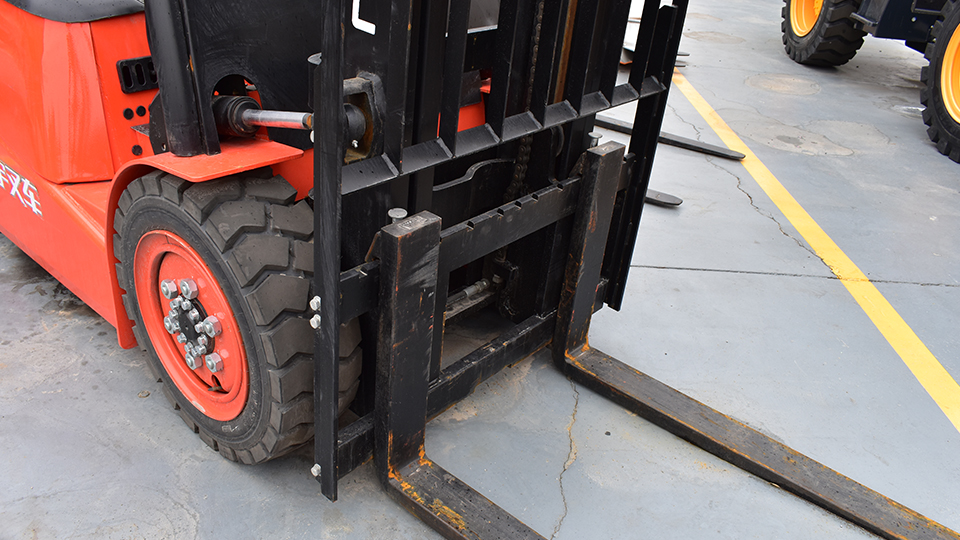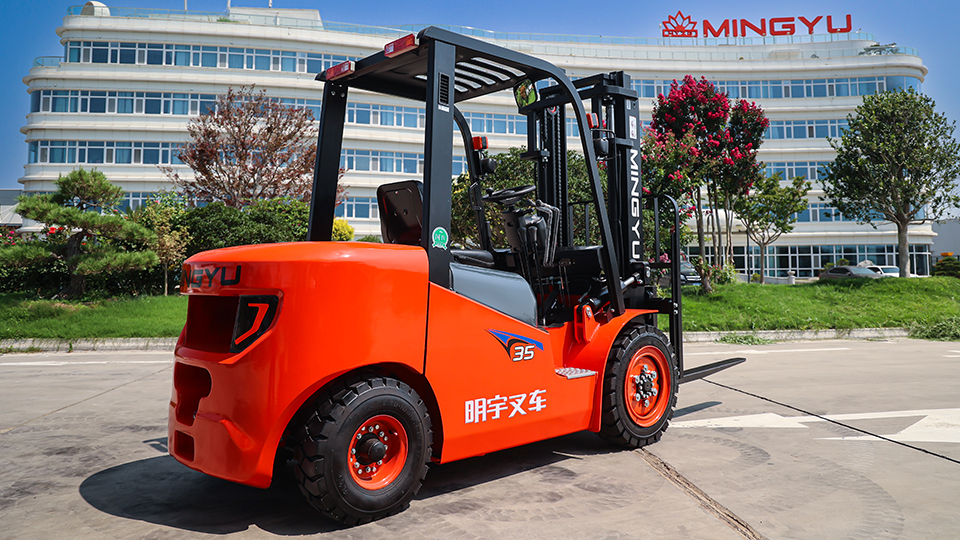
Categorizing Forklift Faults and Repair Urgency
The urgency of a forklift repair hinges primarily on the type of fault discovered. Faults can generally be categorized into three levels of severity: Critical (Immediate), Major (Urgent), and Minor (Scheduled).
1. Critical (Immediate) Repairs
Critical faults present an immediate and unacceptable risk to operator safety, bystander safety, or the structural integrity of the equipment, which could lead to catastrophic failure.
Examples:
Brake Failure: Any noticeable degradation or complete failure of the service or parking brake system.
Steering Malfunction: Loss of hydraulic pressure, excessive free play, or seizing that impairs the operator's control.
Mast or Carriage Structure Damage: Cracks, severe deformation, or broken welds on load-bearing components.
Hydraulic System Leaks (Load-Holding): Leaks in the tilt or lift cylinders/hoses that cause the mast or forks to drift uncontrollably under load.
Safety Interlock Failure: Malfunction of the seat-switch, neutral-start, or other critical safety systems that are designed to prevent unintended operation.
Repair Action: The forklift must be immediately taken out of service (Red Tagged). Operation must cease the moment the fault is discovered, and the unit must not be moved until a qualified technician assesses and repairs the defect. The repair urgency is zero tolerance; the equipment is an imminent hazard.

2. Major (Urgent) Repairs
Major faults significantly impair the operational function or efficiency of the forklift and, if left unaddressed, could rapidly escalate into a critical safety failure or cause extensive secondary damage to expensive components.
Examples:
Engine/Motor Overheating: Persistent overheating that risks catastrophic engine or electric motor failure.
Transmission Slippage or Noise: Indicates significant internal wear that could lead to complete drive failure.
Drive Tire or Wheel Damage: Deep cuts, chunks missing from solid tires, or severe wheel rim damage that compromises stability.
Non-Load-Holding Hydraulic Leaks: Constant, large leaks from auxiliary functions or power steering that lead to rapid fluid depletion, risking pump damage.
Worn or Damaged Forks: Forks worn past the designated heel-thickness limit or severely bent/cracked forks, compromising load security.
Repair Action: The forklift should be scheduled for repair within 24-48 hours, or as soon as possible, depending on the availability of a technician and parts. While not an immediate, absolute safety stop, continued use is a high-risk gamble. Reduced-duty operation (e.g., no heavy loads, slow travel speeds) may be permissible under strict managerial review until the repair window, but is often ill-advised.
3. Minor (Scheduled) Repairs
Minor faults do not immediately threaten safety or cause catastrophic failure but indicate wear and tear that will eventually lead to major issues, degrade performance, or violate operational standards (e.g., excessive emissions).
Examples:
Oil Weepage/Seepage: Very slow, minor leaks from non-critical seals (e.g., differential plug, transmission case).
Cosmetic Damage: Broken lights, missing decals, or dented body panels that don't affect structural integrity.
Minor Electrical Issues: Inoperative horn, non-critical gauges, or minor lighting problems.
Worn Hoses/Belts: Hoses showing surface cracks or drive belts showing minor fraying that are still functional.
Rough Idling or Minor Performance Loss: Subtle engine or motor issues not yet impacting productivity significantly.
Repair Action: These faults should be documented and addressed during the next planned preventative maintenance (PM) service or within a reasonable timeframe, often 1-4 weeks, depending on the severity and PM cycle. The objective is to mitigate future expense and maintain optimal efficiency without disrupting immediate operations.
�� The Technical and Operational Decision-Making Matrix
The "how soon" answer is a function of a multi-variable calculation, often simplified into a Risk-Impact Analysis.
I. Safety and Regulatory Compliance
Safety is the non-negotiable primary factor. Any fault that compromises the stability, braking, steering, or load-holding capability of the forklift necessitates an immediate cessation of use.
OSHA/ANSI Standards: Regulatory bodies mandate that equipment must be kept in a safe working condition. Operating a forklift with known critical defects can lead to heavy fines, legal liability, and, most importantly, serious injury or fatality.
Load Rating Integrity: A critical repair is required if the fault compromises the truck's ability to lift its rated capacity safely (e.g., a defective load backrest or damaged overhead guard).
Operator Trust: A delay in fixing a major safety-related defect erodes operator confidence, leading to cautious, inefficient, and potentially incorrect operation that could themselves cause an accident.
II. Secondary Damage and Financial Implication
A critical, technical consideration is the concept of secondary damage. Delaying a seemingly minor repair can rapidly turn it into an extremely expensive major repair.
Example 1 (Hydraulics): A small hydraulic hose leak (Minor/Major) that depletes the fluid reservoir can cause the hydraulic pump to run dry, resulting in a catastrophic and immediate failure (Critical) of the pump, which is one of the most expensive components to replace. Repair Urgency: Move from Minor/Major to Immediate to protect the pump.
Example 2 (Bearings): A noisy wheel or mast bearing (Minor/Major) indicates wear. Continued operation will cause the bearing to fail completely, potentially damaging the axle, wheel hub, or mast channel. Repair Urgency: Move from Minor/Major to Urgent to prevent component destruction.
Cost-Benefit Analysis: The cost of proactive repair (e.g., replacing a worn seal or a noisy bearing) is almost always a fraction of the cost of reactive repair (e.g., replacing a destroyed pump or a damaged mast channel) plus the additional cost of downtime.
III. Operational Impact (Downtime vs. Delay)
Operational demands often push management to delay a repair, but this decision must be weighed against the inevitable, often longer, period of unplanned downtime a failure will cause.
|
Scenario |
Repair Strategy |
Downtime Cost |
Risk Level |
|
Proactive/Scheduled (Minor Faults) |
Repair during off-peak hours or planned PM cycle. |
Minimal, Predictable |
Low |
|
Urgent/Expedited (Major Faults) |
Pull truck from service for 1-2 days based on parts availability. |
Moderate, Controllable |
Medium |
|
Reactive/Breakdown (Critical Faults) |
Complete failure requires towing, emergency technician call-out, and part sourcing. |
Maximum, Unpredictable |
High |
Technical Takeaway: Scheduling the repair for a major fault requires less time and costs less in labor (no emergency fees) and minimizes the overall disruption compared to waiting for an inevitable breakdown. The ideal response time for a major fault is before the fault results in the cessation of all function.
��️ The Technical Repair Process and Timing
The actual time needed for a repair dictates the "how soon" response. A structured repair process facilitates rapid return to service.
1. Diagnosis and Sourcing (The Critical Delay Factor)
Technician Response: The time it takes for a qualified technician to arrive and perform a preliminary diagnosis can range from immediate (in-house maintenance) to 4-24 hours (external service contract).
Accurate Diagnosis: Modern forklifts (especially electric and IC trucks with complex electronics and CAN Bus systems) require specialized diagnostic tools. Incorrect diagnosis can lead to wasted time and cost.

Parts Sourcing: The availability of replacement parts is often the single biggest bottleneck.
Common Wear Parts: Often available immediately from service van stock or local distributor.
Major/Specialized Components: May require 24 hours to several days if they must be shipped from a regional or national warehouse.
2. The Repair Itself
The actual "wrench time" varies greatly:
Minor Adjustments/Replacements: (e.g., spark plugs, oil change, minor brake adjustment) - 1-4 hours.
Major Component Swaps: (e.g., replacing a hydraulic pump, mast carriage, steer axle assembly) - 4-12 hours.
Complex Overhauls: (e.g., full engine or transmission rebuild, complete wiring harness replacement) - 1-3 days or more.
3. Verification and Return to Service
Post-Repair Testing: A critical step, especially for safety-related repairs (brakes, hydraulics, steering). The technician must perform a detailed inspection and function test, often under a test load, to ensure the repair has fully resolved the issue and introduced no new faults.
Documentation: All repairs must be fully documented, noting the fault, the repair action, parts used, and the final verification results for regulatory compliance and historical analysis.
Technical Guideline: When a major fault is identified, a detailed repair plan, including part lead times, should be established within 2 hours of diagnosis to set an accurate and reliable Estimated Time of Return to Service (ETRS) for operations management.
�� Long-Term Strategic Considerations: Planned vs. Unplanned Maintenance
A proactive approach is the core of an efficient fleet strategy.
Preventative Maintenance (PM) and Condition Monitoring
The best way to control the "how soon" factor is to prevent most critical and major failures through a robust PM program.
Scheduled Intervals: Performing scheduled PM (e.g., every 200/500 hours) allows technicians to identify minor wear parts before they fail.
Fluid Analysis: Analyzing engine oil, transmission oil, and hydraulic fluid can detect high concentrations of wear metals (iron, copper, chrome), indicating an impending component failure (e.g., a failing bearing or clutch pack) long before it becomes audibly or visibly apparent. This allows for repairs to be made proactively on a scheduled basis, rather than reactively during a breakdown.
Telematics and Diagnostics: Utilizing forklift telematics to monitor performance metrics (e.g., battery temperature, fault codes, excessive impacts) provides real-time data to flag potential issues, allowing for predictive maintenance.
Economic Life and Replacement Strategy
The decision to repair a very old forklift (i.e., one past its projected Economic Life) with a major fault is a financial calculation.
"Throwing Good Money After Bad": If the cost of a major repair (e.g., a transmission overhaul) approaches or exceeds 50% of the replacement cost of a new equivalent unit, the strategic answer to "how soon should repairs be made?" is often "never"—the unit should be condemned and replaced.
Increased Reliability: Newer forklifts come with better safety features, emissions compliance, and significantly higher reliability, which often makes replacing an unreliable, old unit more cost-effective in the long run, even compared to a costly repair.
✅ Conclusion: A Framework for Repair Urgency
The determination of "how soon should repairs be made to a forklift?" is a critical management decision that balances safety, operational productivity, and financial prudence.
Safety First (Critical Faults): Immediate cessation of all operation is required for any fault affecting braking, steering, stability, or load-holding. This is non-negotiable and regulatory-mandated.
Protect Assets (Major Faults): Repairs should be made Urgent (within 24-48 hours) for faults that, if allowed to continue, will rapidly cause severe secondary damage to expensive major components (e.g., hydraulic pumps, transmissions, axles).
Optimize Efficiency (Minor Faults): Faults that cause no immediate danger or risk of secondary damage should be addressed during the next scheduled Preventative Maintenance (PM) service to maintain efficiency and avoid future major issues.
A successful fleet maintenance strategy is not about minimizing the cost of individual repairs, but about minimizing the total cost of ownership and maximizing safety through a proactive, condition-based, and scheduled approach to maintenance, turning unplanned breakdowns into predictable, manageable events.
Further Reading and Technical Resources:
OSHA 29 CFR 1910.178 - Powered Industrial Trucks (Safety Standards)
ANSI/ITSDF B56.1 - Safety Standard for Low Lift and High Lift Trucks
The Role of Telematics in Predictive Maintenance for Material Handling Equipment
Name: selena
Mobile:+86-13176910558
Tel:+86-0535-2090977
Whatsapp:8613181602336
Email:vip@mingyuforklift.com
Add:Xiaqiu Town, Laizhou, Yantai City, Shandong Province, China